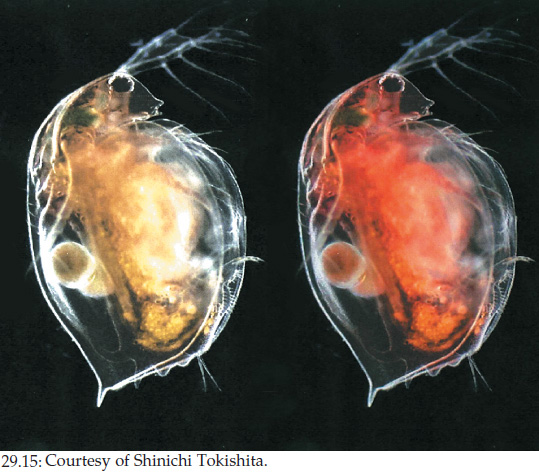CONCEPT29.5 The Phenotypes of Individual Animals Can Change during Their Lifetimes
Although the genotype, or genetic constitution, of an individual animal is constant for the animal’s entire life, countless examples are known of changes in an individual’s phenotype, or observable characteristics. Change of this type is called phenotypic plasticity, which refers to an individual’s ability to display two or more different phenotypes at different times during its life despite a constant genotype. When an individual’s phenotype changes as a result of long-term exposure to a particular environment, the individual is said to acclimate or acclimatize to that environment.
Phenotypic plasticity is common at the biochemical level
Phenotypic plasticity occurs often at the biochemical level, and one of the most important ways it does so is by the action of inducible enzymes. Enzymes are called “inducible” if their concentrations in an animal’s cells, rather than being constant, depend on the animal’s environment or experiences. In other words, with inducible enzymes, the enzyme phenotype can change. Many fish and aquatic invertebrates, for example, have inducible enzymes that respond to long-term changes in body temperature. When winter comes and water temperature falls, these animals acclimatize over days or weeks by producing higher concentrations of enzymes that play key roles in energy metabolism. The fish and invertebrates thus have high concentrations of the enzymes in winter and low concentrations in summer. These enzyme changes make the metabolic functions of the animals less sensitive to long-term changes in temperature than they are to short-term changes.
Detoxification enzymes also provide outstanding examples of plasticity in enzyme phenotype. Human liver enzymes that detoxify ethanol (the alcohol in beer and wine) are usually almost absent in people who do not drink ethanol. However, if a person drinks ethanol regularly, higher concentrations of the enzymes are produced. This helps explain why people who regularly drink are more resistant to drunkenness than people who don’t drink. Enzymes known as P450 enzymes, found throughout the animal kingdom, play important roles in detoxifying a wide range of environmental toxins such as halogenated aromatic hydrocarbons (HAHs). Fish that live in polluted waters have higher levels of P450 enzymes than fish that live in pristine waters.
Phenotypic plasticity also occurs at the scales of tissues and organs
When individual small mammals—such as squirrels or mice—have been living in a warm environment, they have small amounts of brown adipose tissue (BAT; see Figure 29.10), the tissue responsible for nonshivering thermogenesis. Yet when the same individuals experience a cold environment over a period of days or weeks—and therefore become cold-acclimated—their BAT grows dramatically and becomes far more capable of producing heat at a high rate. Because of this plasticity, the animals need not invest in maintaining BAT when their environment is warm, but can have lots of BAT heat production when their environment is cold.
The tiny crustaceans known as water fleas (Daphnia), often abundant in freshwater ponds and lakes, display visibly dramatic phenotypic plasticity (FIGURE 29.15). They are palecolored and contain almost no O2-transporting hemoglobin when their environmental water has a high O2 concentration. Their production of hemoglobin, being phenotypically plastic, changes in other circumstances, however. When individuals experience periods of low environmental O2 concentration, they increase hemoglobin synthesis and turn bright red.

Phenotypic plasticity is under genetic control
How can alcohol detoxification enzymes be increased by the experience of drinking alcohol, and brown adipose tissue be increased by exposure to cold? More generally, how can mechanisms that help meet a stress be increased by that very stress?
The answer is that, over the course of evolution, natural selection can favor patterns of response to environmental challenges. Phenotypic plasticity is a type of evolved genetic programming. During the evolution of phenotypic plasticity, natural selection—rather than favoring a fixed trait, such as sharp teeth in a carnivore—instead favors a genetic program of responses (such as programmed changes in gene expression) so that some environments lead to one set of responses and other environments lead to other sets of responses.
619
CHECKpointCONCEPT29.5
- The metabolic rate of a poikilotherm increases immediately when the temperature of its environment increases. Is this an example of phenotypic plasticity? Explain your answer.
- How might a scientist justify determining the relative purity of a stream by measuring the concentrations of P450 enzymes in the fish that inhabit it?
Phenotypic plasticity is one way animals can control the ways they function. To close this chapter, we will now take a much broader look at animal control systems.